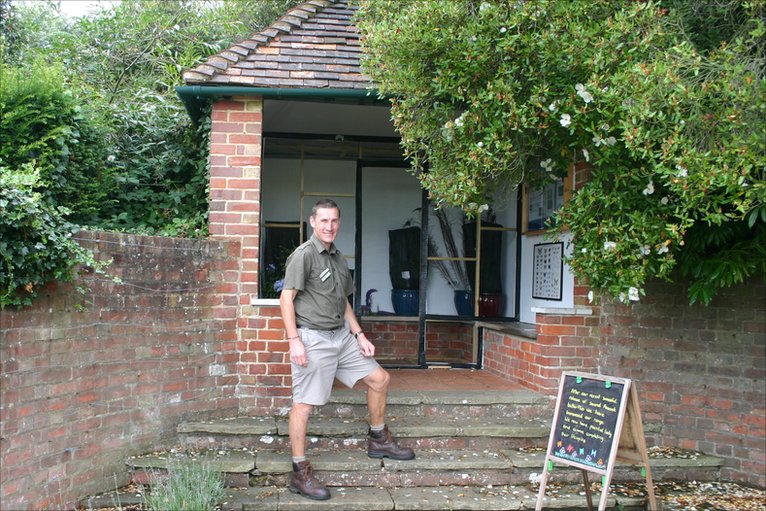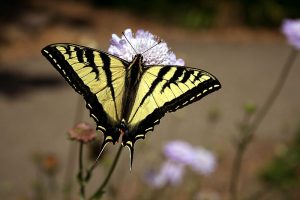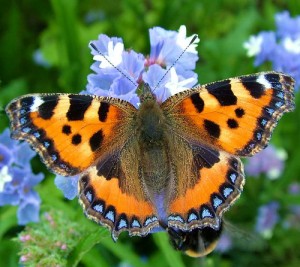
Churchill’s Butterflies Continue to Flourish at Chartwell
Butterflies are back in force at Sir Winston Churchill’s Chartwell. In 2009, the National Trust rebuilt the butterfly hut and gardener Stephen Humphrey took charge of raising butterflies. Nigel Guest, a Chartwell volunteer, immediately reported “a terrific year for butterflies.” For his report and color photos of Churchill’s favorite species see BBC Radio Kent, “Churchill’s Butterfly House at Chartwell.”
David Riddle, a National Trust volunteer at Chartwell, gave me the background of the “Butterfly House” Churchill established to propagate the insects on the grounds of his home:
The Butterfly House was first used as a game larder between 1869 and 1889 by the Colquhoun family, who owned Chartwell between 1830 and 1922, when Churchill bought the estate. Two years later Philip Tilden, his architect, converted the larder to a summer house by removing the east wall. In 1946 it was converted to a Butterfly House. Churchill used it for raising caterpillars and chrysalises. He received advice from butterflies expert L. Hugh Newman, who owned a “butterfly farm” in nearby Sidcup. Lady Churchill planted buddleia, lavender and other nectar-rich flowers in order to encourage the butterflies. Sir Winston changed the walk from gravel to turf and stepping stones in 1950.

Butterflies: A Lifetime Interest
Churchill became fascinated with butterflies as a young officer stationed in India, where they were colorful and prolific. Years later, in 1939, and again after the war, he determined to propagate them at Chartwell. L. Hugh Newman, as David Riddle states, was his chief supplier.
Ronald Golding, Churchill’s Scotland Yard detective during 1946-47, told me an amusing episode involving Newman’s first visit to Churchill:
He took the breeder for a walk round the grounds and gave a general idea of his plans. The expert then gave advice and went into technical details. Mr. Churchill said very little. Rather like a penny dropping in the butterfly man’s mind, you could almost hear him thinking: “Ah, I’ve got the old boy. He’s not nearly as clever as I thought. This is one sphere in which I know a lot more than he does.”
Mr. Newman became just the slightest bit patronizing and boomf! Mr. Churchill came back at him with very lucid comments showing that he was fully acquainted with everything being said. Visibly shaken, the expert never tried to “talk down” again. It was a pattern of conversation I’d noticed with other experts. I can’t help feeling that Mr. Churchill pretended ignorance to a certain extent, then came down like a ton of bricks if there was any attempt to patronize him.
A very successful scheme was put in hand and some of the rarest butterflies and moths of the greatest beauty were hatched out. By careful provision of the right flowers and bushes, the butterflies were kept well fed.
“In Durance Vile”

Churchill’s daughter Lady Soames was not sure when he stopped raising butterflies, but it might have been after an event described by longtime Chartwell secretary and administrator Grace Hamblin, at a 1987 Churchill Conference:
He had a little hut in the garden, which is still there. In those days he had the front covered with gauze, with a gauze door opening into it. A nearby butterfly farm sent him chrysalises. which he liked to see develop. One morning, I was with him spreading out the chrysalises. Upon leaving the little hut, he left the door open. I said, “Did you want to leave the door open, or should I close it?” He said, “I can’t bear this captivity any longer!” Thus we no longer kept butterflies, but they are supposed to remain in the garden once you start. It’s a lovely occupation. When he knew that Chartwell would eventually go to the National Trust and be open to the public he said, “I hope the National Trust will grow plenty of buddleia for my butterflies.”
This charming story reminds us of Churchill’s hatred of imprisonment. In his autobiography, he writes of being jailed by the Boers in the Anglo-Boer War, in a chapter entitled, “In Durance Vile.” Ten years later as Home Secretary, he strove to avoid imprisoning people for trivial offenses and was ahead of his time in his ideas about rehabilitating inmates.







One thought on “Churchill’s Butterflies Continue to Flourish at Chartwell”
Really nice story—most welcome.
Comments are closed.